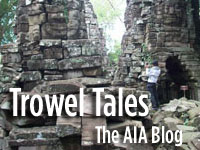Ghosts of Mammoths Past
by Heather Pringle
December 25, 2009
 What can a pinch of dirt from the  Alaska permafrost tell us about the extinction of mammoths and prehistoric horses?  An awful lot,  says an international team of researchers headed by James Haile,  a geneticist at the University of Copenhagen.  By sequencing ancient mitochondrial DNA from soil samples and dating the soil,  Haile and his colleagues concluded that both mammoths and ancient horse species were still grazing Alaskan meadows some 7600 to 10,500 years ago–at least 2500 later than other research suggests.  Their findings appeared last week in an online paper in the Proceedings of the National Academy of Science
What can a pinch of dirt from the  Alaska permafrost tell us about the extinction of mammoths and prehistoric horses?  An awful lot,  says an international team of researchers headed by James Haile,  a geneticist at the University of Copenhagen.  By sequencing ancient mitochondrial DNA from soil samples and dating the soil,  Haile and his colleagues concluded that both mammoths and ancient horse species were still grazing Alaskan meadows some 7600 to 10,500 years ago–at least 2500 later than other research suggests.  Their findings appeared last week in an online paper in the Proceedings of the National Academy of Science
Haile and several of his colleagues have a long-standing interest in the subject of ancient DNA,  and whether this fragile molecule  can really survive degradation over thousands of years in geological layers.  Remember,  we are not talking about ancient DNA encased in animal teeth or bone:  Haile and his colleagues are searching for ancient molecules from urine and faeces in the soil.
Here’s what Haile’s team did in this new study. Â They collected permafrost core samples from the tundra near Stevens Village, and dated the layers in the core by two methods: Â C14 dating and optically simulated luminescence. Â Then the team sequenced the ancient mitochondrial DNA in the layers. Â In the stratum dated between 7600 and 10,500 years ago, they discerned the ancient DNA of woolly mammoth, Â prehistoric horse, moose, Â and snowshoe hare. Â In upper layers dated to more recent times, they found moose, Â hare, and the like, but no trace of woolly mammoth or prehistoric horse.
Team member Eske Willerslev, an ancient DNA expert at the University of Copenhagen, sees this as the beginning of a whole new era in our studies of the ancient megafauna and their mysterious demise.  “With ancient DNA analysis,”  Willerslev said in a prepared statement, “we are completely independent of skeletons, bones, teeth, and other macrofossil evidence from extinct animals.  This greatly increases the possibility of finding evidence of the existence of a species through time.”  Indeed,  the team has coined a new term for this:  they now talk of identifying “ghost ranges” for the  animals.
All this sounds extremely interesting and exciting.  And if  Haile, Willerslev and their colleagues have it right,  researchers will definitely need to rethink their theories about the demise of the mammoths and other large megafauna. The team’s new proposed extinction dates would not mesh in any way with the arrival of human hunters in the Americas or with a proposed comet strike.
But I confess I am skeptical. Â The validity of dirt DNA, for example, Â still seems to be a hotly contested issue among ancient DNA experts. Â Researchers are still debating, for example, Â the authenticity of ancient human DNA extracted from fecal material found Paisley Cave in Oregon, evidence that was used to advance the case of Pre-Clovis humans in the New World.
Big claims require big evidence. Â Haile and his colleagues have now put out the idea that researchers can abandon the quest for skeletal evidence and simply take soil samples to pinpoint the demise of the mammoths. Let’s see other research teams duplicate his findings.
Here’s wishing you all Happy holidays!
Comments posted here do not represent the views or policies of the Archaeological Institute of America.






 Heather Pringle is a freelance science journalist who has been writing about archaeology for more than 20 years. She is the author of Master Plan: Himmler's Scholars and the Holocaust and The Mummy Congress: Science, Obsession, and the Everlasting Dead. For more about Heather, see our
Heather Pringle is a freelance science journalist who has been writing about archaeology for more than 20 years. She is the author of Master Plan: Himmler's Scholars and the Holocaust and The Mummy Congress: Science, Obsession, and the Everlasting Dead. For more about Heather, see our 



